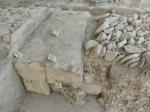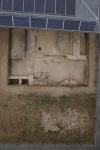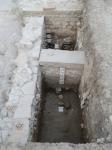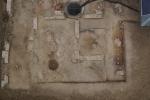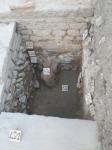Summary (English)
The 16th excavation campaign at Tifernum Mataurense continued the investigation of the Roman baths, situated in the locality of Colombaro at Sant’Angelo in Vado (PU), where Macerata University has been working since 2003. In particular, work continued in the southern sector of the baths, both in quadrant I in correspondence with the west pool and the south-west corner, and in the adjacent quadrant II.
In the first trench and inside the pool the earliest identified phase was the positioning of a compact and smooth rectangular limestone slab (c. 3 × 2 m), incorporated into the opus signinum floor of the pool, perpendicular at the centre to the south wall. The position and technical data suggest it was a sort of platform on which an element of uncertain nature (sculptural, pseudo-architectural, or functional) stood. The type of set up places the slab within the first phase of the complex, previously dated to the early or beginning of the middle Empire. Subsequently, a filling system for the pool was constructed by assembling reused stone blocks and layers of fill, from which the sparse finds, including thin-walled ware and middle Adriatic pottery, confirm that the baths were reorganised during the mid imperial period.
In the south-west corner, at a lower depth, there was a yellowish, compact clayey layer, probably close in phase with the natural. This was followed by a construction phase, represented in the north-east section by a corner wall, in irregular masonry made of small-sized materials, from which a horizontal terracotta slab projected. Its surface was badly deteriorated, and its position and the construction technique suggest it was part of a room with a terracotta floor of late Republican date. The construction on top of pre-existing structures of a room, perhaps heated, is attributed to the building phase of the baths, dated to around about the 1st century A.D. What remains consisted of an opus vittatum wall, faced with opus signinum, a rudus of stone chippings, cobblestones and mortar, and a few patches of a layer of fragmented tiles. The successive layers of dumped materials, interventions to restore the structures and the positioning of a partitioning slab, can be attributed to the reorganisation of the area.
In the eastern half of quadrant II, the western part of the heated room was exposed, already identified in trench I and attributable to the first construction phase of the baths. Badly damaged by modern cuts, all that remained were a section of the south wall and a part of the hypocaust with opus signinum floor and eight equidistant circular suspensurae. What was probably the praefurnium was identified in the central part of the trench. Although not completely excavated it appears to be situated in a rectangular room with opus vittatum walls. The mouth was formed by baked sandstone slabs, on an east-west alignment, and c. 70 cm apart. The rebuilding of the praefurnium’s peripheral walls and of the threshold, the blocking of the mouth with cement and the creation of a floor surface outside the hypocaust can be attributed to a phase of reorganisation in the mid-imperial period.
The overlying layers relate to the late antique/post-antique abandonment, a large robber trench of Renaissance date, and modern trenches for vine planting, which over the course of time have badly damaged the ancient structures.
- Emanuela Stortoni - Dipartimento di Scienze della Formazione, dei Beni Culturali e del Turismo – Area di Ricerca Beni Culturali – dell’Università degli Studi di Macerata
Director
Team
- Enzo Catani - Dipartimento di Scienze della Formazione, dei Beni Culturali e del Turismo – Area di Ricerca Beni Culturali – dell’Università degli Studi di Macerata
- Walter Monacchi
- Francesca Eugenia Damiani
- Alberto Baldoni
Research Body
- Università degli Studi di Macerata
Funding Body
- Comune di Sant’Angelo in Vado
- Comunità Montana ‘Alto e Medio Metauro’ di Urbania
- Provinciale di Pesaro e Urbino
- Università degli Studi di Macerata





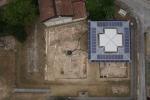
![Download [PDF]](/excavation/skins/fasti/images/results/download_sml.png)
